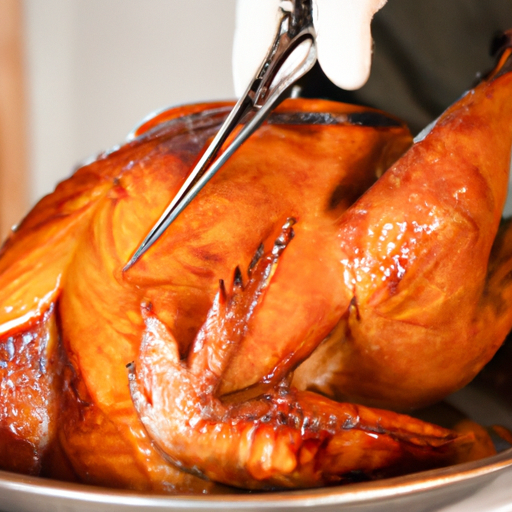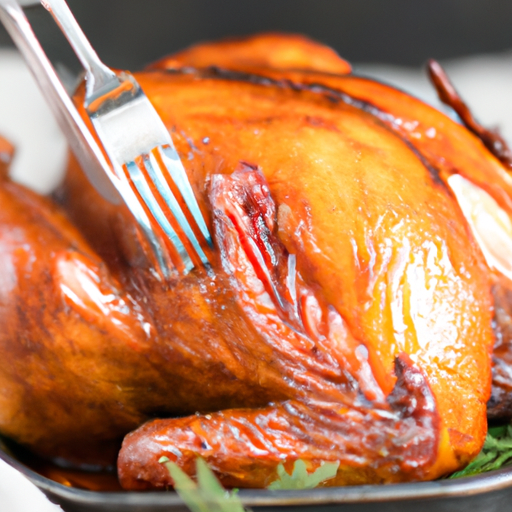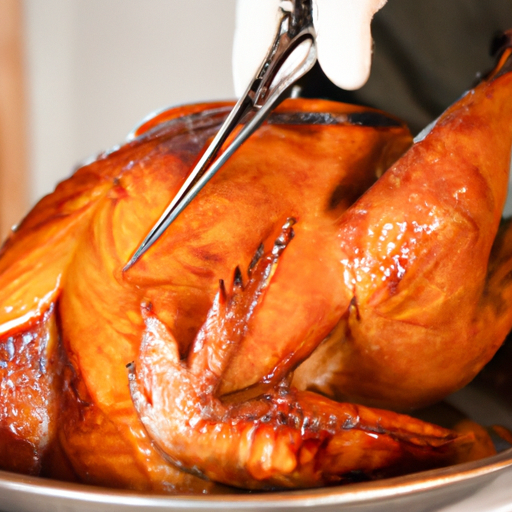Are you preparing to cook a turkey for the first time? Look no further! “Essential Turkey Cooking Guidelines” is here to help you achieve the perfect turkey for your holiday feast. This handy turkey cooking chart provides all the necessary information you need to cook a delicious and juicy turkey, including recommended cooking times based on the weight of your bird, internal temperature guidelines to ensure it’s fully cooked, and helpful tips for a flavorful and moist turkey. With these essential guidelines at your fingertips, you’ll impress your family and friends with your culinary skills this holiday season!
Thawing the Turkey
Thawing the turkey is an essential first step before you begin cooking it. There are three methods you can use to thaw your turkey: refrigerator thawing, cold water thawing, and microwave thawing.
Refrigerator Thawing
Refrigerator thawing is the recommended method for thawing your turkey. Simply place the wrapped turkey in the refrigerator and allow it to thaw slowly over time. The general guideline is 24 hours of thawing time for every 4-5 pounds of turkey. So, if you have a 20-pound turkey, it will take approximately 4-5 days to thaw completely in the refrigerator.
Cold Water Thawing
If you don’t have enough time for refrigerator thawing, the cold water thawing method is a quicker alternative. Fill a sink or a large container with cold water and submerge the wrapped turkey, ensuring it is fully covered with water. Change the water every 30 minutes to maintain a safe temperature. Plan for 30 minutes of thawing time per pound, so a 20-pound turkey will take approximately 10 hours to thaw using this method.
Microwave Thawing
If you’re really in a time crunch, you can use your microwave to thaw the turkey. Follow the instructions provided by your microwave’s manufacturer for defrosting large meats. Be sure to remove all packaging materials and any metal clips or trussing before attempting to thaw in the microwave.
Preparation before Cooking
Before you start cooking your turkey, there are a few important steps to take to ensure it is ready for the oven.
Removing the Giblets
Most turkeys come with a package of giblets tucked inside the cavity. Before cooking, be sure to remove these giblets. They can be discarded or used to make giblet gravy or stock.
Rinsing the Turkey
Rinsing the turkey is a matter of personal preference. Some people believe that rinsing the turkey helps remove any potential bacteria, while others argue that it can spread bacteria around the kitchen. If you choose to rinse your turkey, be sure to do so with cold water and thoroughly clean all surfaces that come into contact with the raw turkey.
Patting the Turkey Dry
After rinsing (if you choose to do so), pat the turkey dry with paper towels. This helps remove any excess moisture, creating a crispier skin when cooked.
Seasoning the Turkey
Seasoning is the key to adding flavor to your turkey. There are countless recipe options for seasoning your turkey, from simple salt and pepper to elaborate herb blends. Choose a seasoning that suits your taste preferences and generously apply it to the turkey, both inside the cavity and on the skin.
Trussing the Turkey
Trussing, or tying, the turkey helps it cook evenly and maintain its shape. To truss the turkey, tie the legs together with kitchen twine and tuck the wings under the body. This will help prevent the wings and legs from drying out during cooking.

Cooking Methods
Once your turkey is prepped and ready, it’s time to choose your cooking method. There are several popular methods to choose from, each offering a unique flavor and cooking experience.
Roasting
Roasting is the most traditional method for cooking a turkey. It involves cooking the turkey in the oven at a steady temperature until it reaches a safe internal temperature.
Grilling
Grilling a turkey adds a smoky flavor and creates a beautifully crispy skin. It requires a bit more attention and skill, but the results are well worth it.
Deep Frying
Deep frying a turkey results in a moist, flavorful bird with a crispy exterior. However, it is important to take caution when deep frying, as it can be a fire hazard if not done properly.
Smoking
Smoking a turkey infuses it with a delicious smoky flavor. It involves cooking the turkey over indirect heat with the addition of wood chips to create smoke.
Roasting Times and Temperatures
Knowing the correct roasting times and temperatures is crucial to ensure your turkey is cooked to perfection. The cooking times and temperatures may vary depending on the size of your turkey and the cooking method you choose.
Conventional Oven Roasting
For a conventional oven, the general rule for roasting a turkey is to cook it at 325°F (165°C). The USDA recommends around 15-20 minutes of cooking time per pound of turkey. However, it’s essential to use a meat thermometer to check the internal temperature for doneness.
Convection Oven Roasting
When using a convection oven, the cooking time can be reduced by 25%. The recommended temperature remains the same at 325°F (165°C), but the cooking time per pound will be slightly shorter than in a conventional oven.
Covered Roasting
Covering the turkey with foil or a roasting pan lid helps trap moisture and heat, resulting in a more tender and moist turkey. However, this method can also slow down the browning process, so it’s common to remove the cover during the last hour of cooking to achieve a crispy skin.
Uncovered Roasting
Uncovered roasting allows the turkey to brown evenly and develop a crispy skin. It is the preferred method if you want a beautifully golden turkey.
Roasting Bag Method
Using a roasting bag can help retain moisture and create a self-basting effect. Follow the instructions on the roasting bag package for proper usage and cooking times.

Internal Temperature
Understanding the safe internal temperature of your turkey is crucial for food safety. The USDA recommends cooking the turkey until it reaches a minimum internal temperature of 165°F (74°C) in the innermost part of the thigh, wing, and thickest part of the breast. Using a meat thermometer is the best way to accurately measure the internal temperature of your turkey.
Stuffing the Turkey
Stuffing a turkey is a timeless tradition that adds flavor and moisture to the bird. However, it’s important to follow safety guidelines when stuffing your turkey to avoid the risk of foodborne illness.
Basic Stuffing Recipe
A basic stuffing recipe usually includes bread cubes, onions, celery, herbs, and broth or stock for moisture. Be sure to prepare the stuffing just before you’re ready to cook the turkey to ensure optimal food safety.
Guidelines for Safe Stuffing
To ensure safe stuffing, it is recommended to stuff the turkey loosely to allow for even cooking. The internal temperature of the stuffing should reach the same safe minimum temperature of 165°F (74°C) as the turkey itself. Additionally, when checking the stuffing temperature, it is important to insert the meat thermometer in the thickest part of the stuffing.
Basting and Seasoning
Basting and seasoning are important techniques that enhance the flavor and moisture of your turkey.
Basting Techniques
Basting involves brushing or spooning pan juices or other liquids over the turkey while it cooks. This helps to keep the turkey moist and adds additional flavor. Baste the turkey every 30 minutes to an hour, depending on your cooking method.
Seasoning Options
In addition to the initial seasoning applied before cooking, you can also add flavor by using seasoned butter, marinades, or herb rubs. Experiment with different flavors and seasonings to find your favorite combination.
Cooking Tips and Troubleshooting
Even with the best plans, cooking a turkey can sometimes come with challenges. Here are some tips to help you navigate common issues and ensure a successful outcome.
Using a Meat Thermometer
Investing in a good meat thermometer is essential for cooking a turkey to perfection. By monitoring the internal temperature, you can ensure that your turkey is fully cooked without risking it becoming dry or undercooked.
Avoiding Dry Turkey
To avoid dry turkey, it’s important not to overcook it. Use a meat thermometer and remove the turkey from the oven when it reaches the recommended internal temperature of 165°F (74°C). Additionally, basting the turkey and using a roasting bag or covering it can help retain moisture.
Preventing Overcooking
To prevent overcooking, keep a close eye on the turkey’s internal temperature. Remember that the temperature will continue to rise a few degrees after removing it from the oven. Allow the turkey to rest for at least 15-20 minutes before carving to give the juices time to redistribute.
Dealing with Undercooked Turkey
If you find that your turkey is undercooked, you can return it to the oven and continue cooking until it reaches the desired internal temperature. Be sure to cover the turkey with foil to prevent excessive browning while the inside cooks.
Handling a Turkey Emergency
Sometimes, despite all your planning, unexpected problems may arise. If you encounter a turkey emergency, such as a turkey that is taking longer to cook than anticipated, remain calm and assess the situation. You can always adjust the cooking time or temperature, cover the turkey if it’s browning too quickly, or use foil to tent the turkey if it’s becoming too dark.
Resting and Carving
Allowing your turkey to rest before carving is crucial for a moist and tender result.
Resting the Turkey
After removing the turkey from the oven, tent it loosely with foil and let it rest for at least 15-20 minutes. This resting period allows the juices to redistribute, resulting in a more flavorful and tender turkey.
Carving Techniques
When it comes to carving the turkey, start by removing the legs and wings before slicing the breast meat. Use a sharp carving knife or an electric knife for smooth and even slices. Take your time and enjoy the process.
Leftover Turkey Storage
After your delicious feast, you may have leftovers to enjoy. Proper storage and safety are essential to avoid foodborne illness.
Proper Storage and Safety Tips
Store leftover turkey in airtight containers or resealable bags in the refrigerator. Consume the leftovers within 3-4 days. If you’re not able to finish the leftovers within this time frame, consider freezing them for later use. When reheating, make sure the turkey reaches a safe internal temperature of 165°F (74°C) to avoid any potential risks.
